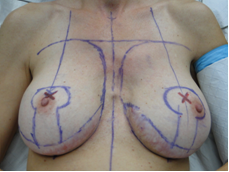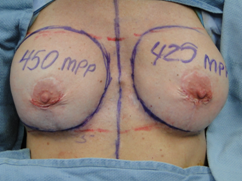There are a number of determining factors to take into consideration when choosing the appropriate breast implants and placement of the implants to obtain the best results.
Depending on your current breast size and overall goals, the implants may be placed under the mammary gland (subglandular) and over the pectoral muscle (this approach is commonly referred to as "over-the-muscle" or "overs") or the implants can be placed under the pectoral muscle (this approach is referred to as submuscular, "under-the-muscle" or "unders"). Each type has its own individual benefits and drawbacks.
Submuscular breast implants (under-the-muscle)
This technique places the implants under the chest muscle behind the breast. It is two-thirds covered by the muscle itself and the remainder is covered by the breast's connective tissue. The chest muscle can accommodate this because it's connected to the chest wall along the muscle's outer perimeter, creating a natural pocket where the implant is inserted.
Implants placed under the muscle tend to create a better and more natural look. Since the implant is concealed underneath the pectoral muscle, ripples or the edges of the implant are covered. This tends to produce a more attractive appearance and feel to the breasts. Because the implant is behind the muscle, interference during mammograms is unlikely. The breast tissue can be easily checked. More importantly, implants under the muscle are not prone to capsular contracture.
Despite these advantages, recovery may be prolonged and be more uncomfortable. This discomfort is due to the manipulation involved in positioning the implants underneath the muscle tissue.
Many women desire a more natural look and feel and therefore, prefer to choose placement under the muscle.
Subglandular breast implants (over-the-muscle)
This technique places the implants directly behind the natural breast tissue and in front of the pectoral muscle. Placing implants over the muscle allows larger implants to be used and more cleavage can be easily created with less recovery time and less discomfort because there is no disturbance of the musculature.
Athletes and active women may prefer over-the-muscle implants because it won't affect their muscles. Implants placed under the muscles can look distorted and unnatural when the chest is flexed, which can be very concerning for women who weight train or professional bodybuilders
Despite these positives, over-the-muscle is not usually the choice of most doctors and there are some potential negatives:
- greater risk of rippling and palpation of the implants
- mammograms are more difficult to perform
- the overall look will be more rounded and unnatural
- women who have very little breast tissue are not good candidates for this type of placement
- capsular contracture (scar tissue) is more likely to occur with implants placed over-the-muscle This condition involves scar tissue formed around the implant causing firmness
- implants placed under the muscles can look distorted and unnatural when the chest is flexed, which can be very concerning for women who weight train or professional body builders
This 40-year-old patient from Las Vegas, Nevada was unhappy with the appearance of her breasts. Initially, her implants were placed over the muscle.


In order to achieve the patient's goals, the doctor discussed a two-staged procedure her. The first stage was to remove her implants and perform a breast lift (mastopexy). After a couple of months of allowing the incisions to heal, she returned for the breast augmentation portion of the surgery. The implants can now be placed submuscularly for the "look" that she is wishing to achieve.
It is important to discuss your concerns regarding implant placement with your board-certified plastic surgeon prior to your procedure. Placement may be determined based on your body type, preference, and/or lifestyle.



